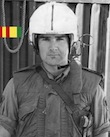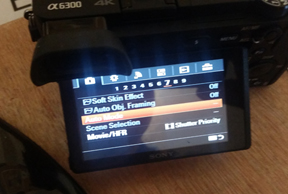|
Author
|
Topic: Digitizing film
|
Bill Proctor
Film Handler

Posts: 60
From: Mooresville, IN, USA
Registered: Apr 2018
|
 posted August 07, 2018 03:12 PM
posted August 07, 2018 03:12 PM



There are many of us here that has probably tried to digitize our own film with basic equipment and with not so good results, film roll being the main culprit. I recently purchased one of the new Sony a6300 mirrorless digital cameras.
By following these steps, you can digitize your film at normal projection speeds with this camera without any film roll or flicker what-so-ever.
1.) Set your projector film speed at the speed you filmed with. 2.)Set the ISO on the digital camera to 640.
3.) Set the white balance at Incandescent.
Step 4.)And most important set the Movie/HFR to Shutter Priority (see photo.) This step eliminates all film roll and flicker while being digitized.
Feel free to ask any questions but before you do, I don't know if you can do this with other digital cameras. I've digitized film being projected on the wall, through a Vintage Kalimar Video transfer system and just a mirror and ground glass arrangement, all with the same positive results.
If I knew how I could post a short digitized film clip here on the forum. The camera is kind of expensive but I plan to use it for other projects too.
Bill

--------------------
US Army
Combat Motion Picture Photographer,
Vietnam, 1966-1967.
Trained at the US Army Pictorial Center, Astoria New York. 1965-1966, Which is now the Kaufman Astoria Motion Picture Studios.
| IP: Logged
|
|
|
|
|
|
Bill Proctor
Film Handler

Posts: 60
From: Mooresville, IN, USA
Registered: Apr 2018
|
 posted August 08, 2018 09:11 PM
posted August 08, 2018 09:11 PM



super 8 film digitizing with the Sony a6300 camera
See the YouTube video above. Please keep in mind that this is a very old film. below are the settings for the Sony a6300 Mirrorless Camera.
Bill
An experiment digitizing super 8 film with a new Sony a6300 mirrorless camera. Elmo GS-800 projector, no mods. A mirror and ground glass combination to transfer the film. Digitized in real time, about 3 1/2 minutes for a 50 foot roll of film, no film roll or flickers. This is old footage I took in 1984, it hasn't been cleaned, or color corrected. Film was projected at the same speed it was filmed, Camera settings:
HDMI Settings: 1080p.
24p/60p Output: 24p.
File format set to: XAVC S HD.
Record Setting, set to: 24p 50M.
Focus Mode: Continuous AF.
Focus Area set to:Wide.
ISO set to : 640
The Control dial set to: 20 (Same as the old shutter speed dials)
White balance set to: Incandescent.
Movie/HFR set to: Shutter Priority.
I don't know if this will work with any other mirrorless digital cameras, but it should work with the Sony cameras that have the same settings such as the a6000 and a6500.
I'm probably going replace the ground glass with a Fresnal glass. It will distribute the light across the film more evenly and no hot spots.
--------------------
US Army
Combat Motion Picture Photographer,
Vietnam, 1966-1967.
Trained at the US Army Pictorial Center, Astoria New York. 1965-1966, Which is now the Kaufman Astoria Motion Picture Studios.
| IP: Logged
|
|
Nantawat Kittiwarakul
Master Film Handler
Posts: 280
From: Rajburana, Bangkok, Thailand
Registered: Aug 2017
|
 posted August 08, 2018 09:20 PM
posted August 08, 2018 09:20 PM




Once tried with my good'ole NEX 5N with surprising good result.
- Full manual mode.
- Frame rate:50p (I live in PAL land btw) for best result,25p should work OK too.
- The projector's speed:16.67fps,more on that later.
- White balance with lamp on,no film in the gate. (It was modified with LED backlight beforehand) Or playing around with the camera's preset to do preliminary color correction and give final touch in the NLE.
- Test-run the setup,adjust the projector's speed to get least amount of flicker. If correctly done,there's no flicker left whatsoever. ![[Big Grin]](biggrin.gif)
- If you do "off-the-wall-projection" approach,adjust the exposure with the lens's iris only,keep the shutter speed fixed at 1/50 second.
On my test setup,I tried project DIRECTLY into the camera's sensor. And it WORKS. ![[Cool]](cool.gif) With some tune-up the result would be more than enough for me then. With some tune-up the result would be more than enough for me then. ![[Big Grin]](biggrin.gif) ![[Big Grin]](biggrin.gif)
--------------------
Just a lone collector from a faraway land...
| IP: Logged
|
|
Bill Proctor
Film Handler

Posts: 60
From: Mooresville, IN, USA
Registered: Apr 2018
|
 posted August 08, 2018 09:34 PM
posted August 08, 2018 09:34 PM



Natawat..
No modifications to anything.
Projector ran at the same speed as the camera that shot the film 24fps.
No mods to the projector lamps, motors etc.
I understand the 16.6 fps projector speed, this is easier in my opinion and straight forward.
And, no film roll or flicker, as long as your splices are good..
Bill
--------------------
US Army
Combat Motion Picture Photographer,
Vietnam, 1966-1967.
Trained at the US Army Pictorial Center, Astoria New York. 1965-1966, Which is now the Kaufman Astoria Motion Picture Studios.
| IP: Logged
|
|
Bill Proctor
Film Handler

Posts: 60
From: Mooresville, IN, USA
Registered: Apr 2018
|
 posted August 09, 2018 10:32 AM
posted August 09, 2018 10:32 AM



This short clip has sound, YouTube didn't recognize the format I rendered the audio to (MP-3).
Next time I'll render the audio and film together.
The Sony has the ability to record sound through the microphone input on the camera, problem is...it doesn't have a headphone input.
To remedy this, I've ordered a Saramonic Audio Mixer.
It has two inputs, volume and tone controls, headphone and microphone inputs...$50.00.
You can mix the sound right from your pojector's aux out jacks.
I have a Elmo GS-1200 and Elmo GS-800, to me the 800 has the best sound.
--------------------
US Army
Combat Motion Picture Photographer,
Vietnam, 1966-1967.
Trained at the US Army Pictorial Center, Astoria New York. 1965-1966, Which is now the Kaufman Astoria Motion Picture Studios.
| IP: Logged
|
|
|
|
Bill Proctor
Film Handler

Posts: 60
From: Mooresville, IN, USA
Registered: Apr 2018
|
 posted August 09, 2018 02:23 PM
posted August 09, 2018 02:23 PM



Mike,
In the clip I posted there is a hot spot in the middle of the clip, because the mirror I am projecting onto is very close to the projector's lens..
Right now, I am projecting the image onto a mirror and ground glass.
Since the bulb in the Elmo GS-800 is so hot, I think a combination of a Fresnel glass on top of the ground glass should eliminate the hot spot.
That's typically what a Fresnel glass is used for is to distribute the projected light evenly across the serface of the
Fresnel.
Fresnel's are also used in large format photography.
I have one 4" X 5" here in my gear I need to dig up to see if this will work.
Bill
--------------------
US Army
Combat Motion Picture Photographer,
Vietnam, 1966-1967.
Trained at the US Army Pictorial Center, Astoria New York. 1965-1966, Which is now the Kaufman Astoria Motion Picture Studios.
| IP: Logged
|
|
|
|
|
|
|
|
|
|
Bill Proctor
Film Handler

Posts: 60
From: Mooresville, IN, USA
Registered: Apr 2018
|
 posted August 11, 2018 05:05 PM
posted August 11, 2018 05:05 PM



(2. BTW, did you post-process the film WRT framerate? That is, have you applied "Optical flow"-types of interframe estimations of most image editor apps? The footage is very smooth for a 18p film.)
Warner, Look, I don't digitize film professionally (it's a hobby for me) so I'm not sure what you are talking about?
Werner..
Yes the Sony a6300 is capable of MF, I was a combat motion picture photographer in Vietnam in 1966-1967, so I know how to focus a camera, particularly in stressful situations such as combat, but in this instance since it wasn't critical, I used AF strictly as a matter of convenience.
And, I'm not sure where you got the impression this film was shot at 18fps? This film was shot at 24fps and rendered at the same frame rate using Sony Vegas Pro 15.
Nothing special as far as post editing other then a little color correction and rendering to a file that would upload to YouTube.
In this experiment my idea was to use the old adage KISS, "Keep it Simple Stupid".
As stated in one of my earlier posts, I have two rolls of Kodak 50D film being processed as I am writing this.
Once I invert the film to a positive image and do the necessary color correction, I'll post a small segment of the film here and use the manual focus function of the a6300.
In the next week or so, I plan to purchase a Blackmagic Design Video Assist High Resolution HDMI Recorder/Monitor. It will make it easier for these old eyes to focus my Sony a6300.
Bill
[ August 12, 2018, 08:31 AM: Message edited by: Bill Proctor ]
--------------------
US Army
Combat Motion Picture Photographer,
Vietnam, 1966-1967.
Trained at the US Army Pictorial Center, Astoria New York. 1965-1966, Which is now the Kaufman Astoria Motion Picture Studios.
| IP: Logged
|
|
|
|
|



 UBBFriend: Email this page to someone!
UBBFriend: Email this page to someone!
 Printer-friendly view of this topic
Printer-friendly view of this topic



 UBBFriend: Email this page to someone!
UBBFriend: Email this page to someone!
 Printer-friendly view of this topic
Printer-friendly view of this topic